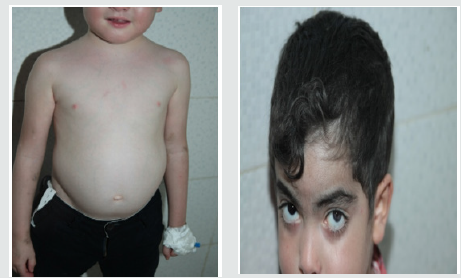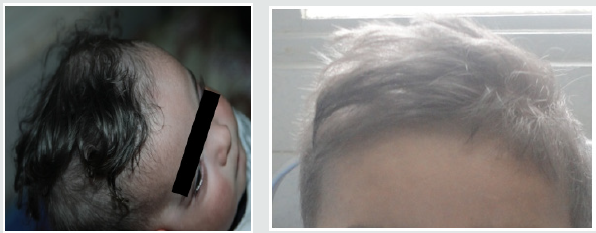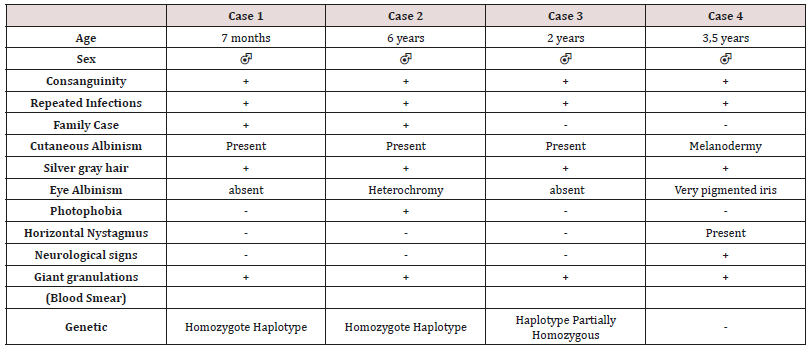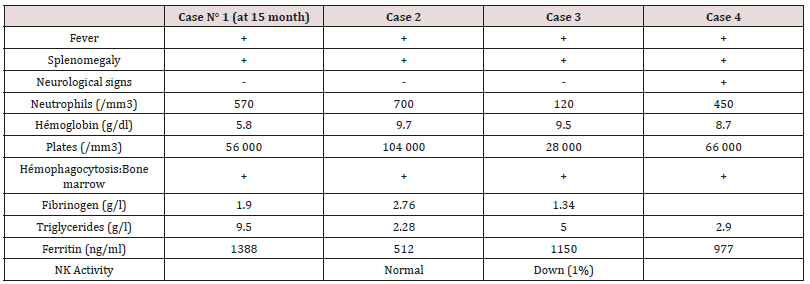Lupine Publishers | LOJ Immunology and Infectious Diseases
Abstract
The present study was carried out to evaluate the activities of the
Lactobacillus species (LAB) isolated from “burukutu” and
pig hindgut with patented probiotics on body weight, hemogram and E.
coli infection control in weaned pigs. Sixty (60) large
white breed of weaned pigs, aged between 30-35 days old with an average
weight of 5 kg. They were randomly allotted to five
replicate groups with six pigs each. Group A1 were administered 0.8 ml
(6x106cfu) of lactobacillus isolated from “burukutu” and
inoculated into wet feed, Group A2, 0.8 ml lactobacillus from “burukutu”
(6x106cfu) inoculated in dry feed. Group B1, had, 0.8 ml
(6x106cfu) of lactobacillus bacteria isolated from hindgut of pigs and
inoculated into wet feed; Group B2, 0.8 ml (6x106cfu) dry
feed containing lactobacillus from Pig hindgut. Group C1, 0.8 ml
(6x106cfu) fermented liquid feed inoculated with Bacillus subtilis
and Bacillus pumilis; Group C2, 0.8 ml (6x106cfu) dry feed inoculated
with Bacillus subtilis and Bacillus pumilis. Group D1, 0.8 ml
(6x106cfu) fermented liquid feed inoculated with Lactobacillus
acidophilus; Group D2, 0.8 ml (6x106cfu) dry feed inoculated with
Lactobacillus acidophilus. Group E1, fed wet basal diet; Group E2, fed
dry basal diet. Animals in the various treatment’s groups were
infected orally with 6 ml (1x1010cfu·ml-1) of E. coli bacteria. Weekly
body weight, hematological values and faecal shedding of E.
coli post infection were evaluated. WBC, lymphocytes, neutrophils and
total protein values were significantly high (p<0.01) in the
treatment groups from week 4 to week nine. The wet form of the feed in
each treatment produced significantly heavier animals
(p<0.01) with an average weight of 25 kg. All dietary treatments
showed significant reduction (p<0.05) in E. coli counts. The present
study has demonstrated that lactobacillus species isolated from
“burukutu” and pig-hindgut was able to improve weight gain and
performance of weaned pigs. Therefore, isolated bacteria from “burukutu”
and pig hindgut can serve as potent probiotics and
growth promoters.
Keywords: Burukutu; Pig Hindgut; Lactic Acid Bacteria; Escherichia Coli Infection Body Weight; Haematology
Introduction
The neonatal period is a critical time in piglet ontogeny,
because the gastrointestinal tract (GIT) and immune system are
not yet fully developed [1]. These in efficiencies make piglets
vulnerable to invasion by pathogenic microorganisms and with
their low resistance to diseases affect the whole process of
individual development [2]. Supplementation with Lactic Acid and
Bacteria (LAB) in neonatal piglets can regulate the formation of
the piglet gut microflora, thus benefiting the health of piglets [1,3]
Currently, there is growing attention on fermented pig feed because
it improves growth performance [4-6] and influence the bacterial
ecology of the gastrointestinal tract (GIT), in particular members
of the family Enterobacteriaceae, including Salmonella spp [6,7].
A considerable amount of research has been conducted to select
beneficial strains of lactic acid bacteria for fermented liquid pig
feed production for example, [6,8] tested 146 strains of bacteria for
their ability to control Salmonella. Bacterial species often used for
inoculating feed to produce fermented liquid feed are Lactobacillus
plantarum and Pediococcus spp [8]. In recent years, reports have
described the beneficial effects of LAB, such as regulation of the
intestinal microflora, inhibition or prevention of pathogens in the
gastrointestinal tract, enhancement of intestinal mucosal immunity
and maintaining intestinal barrier function [9,10]. The aim of this
study, therefore, was to determine the invivo effect of some selected
fermenters, on weight gain and haemogram of weaned pigs.
Materials and Methods
Study Area
The study was carried out in Samaru Campus of A.B.U, Zaria,
Sabon Gari Local Government Area of Kaduna State and Located on
Latitude (11°11´N, 07, 38´E, 686m above sea level) in the Northern
Guinea Savannah with temperature ranging from 13.8° to 36.7° C.
and an annual rainfall of 1092.8mm [11]. Agriculture in Zaria can
be divided into two types: Rainfall type (from May to October) and
irrigation farming in the dry season (from November to April). Dry
season farming is the second most prevalent Agricultural activity
in Zaria with vegetables being the common produce, but in some
cases, fruits are sandwiched among cereal crops [12].
Ethical Approval
Approval for the conduct of this research was obtained from the
ethical clearance committee for animal use and care of Ahmadu Bello
University Zaria; with the approval number: ABUCAUC/2016/005.
Source of Experimental Animals
A total of 60 Large white breed of weaned pigs aged 42-60 days
old with average body weight of 5.5 kg were sourced from breeders
in Hayin Mallam, a small village (settlement) in Samaru, Sabon-Gari
Local Government Area of Kaduna State and popularly known as
‘Pig-City’. Forty-eight (48) of them were sheltered in the piggery
pen of the Division of Agricultural colleges Samaru, Zaria. Whilst
the remaining 12 weaners which will serve as the control group,
were housed separately in the Piggery pens of the Department of
Veterinary Medicine, Faculty of Veterinary Medicine, A.B.U Samaru,
Zaria, Kaduna State these separation was done, so as to avoid cross
contamination of diseases. The Pigs were fed ad libitum with water
and commercial Pig Weaner diet (Table 1) containing 21% crude
protein and 3606 kcal ME/kg.
Table 1: Feed composition for weaned pigsy.
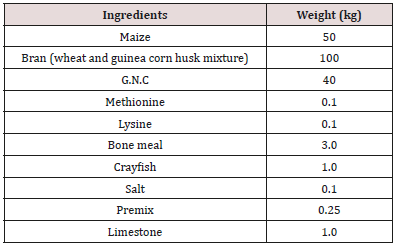
The ingredients composing the feed were mixed thoroughly and
bagged in 100kg grain bags to ease transportation and stored at
room temperature in the feed store of the Department of Medicine,
Faculty of Veterinary Medicine, Ahmadu Bello University, Zaria.
Prior to the feeding with the experimental feed mixes, the following
base-line parameters were determined for the experimental
animals: For haematological parameters, white blood cells (WBC)
especially neutrophils, lymphocytes, basophils and eosinophils
were evaluated. These parameters were determined using the
automatic blood analyzer (CELL-Dyn 3200, Abbott Lab, Abbott
Park, IL). Blood Samples were centrifuged at 6.67g at 40C.
Body Weight
All the pigs in each group were weighted weekly, using a salter’s
scale hung on a beam to support the animal. The following mix
ratios of feed versus fermenters were used in mixing wet and dry
feed forms for feeding of the experimental animals: 8 kilograms
of the feed was weighed using a kitchen scale and poured into a
pair of 10liters plastic buckets into which 0.8mls of the overnight
culture of lactobacillus bacteria was added and thoroughly mixed.
Then, 8 liters of distilled water was added to one of the buckets and
stirred with a clean spatula while the feed-mix in the second bucket
was left dry. This procedure was repeated for other fermenters.
However, the control feed-mix was constituted without inclusion of
any of the fermenters used for the other experimental feed-mixes.
Experimental Design
Table 2: Experimental grouping of the weaned pigs based on dietry treatment

The weaned pigs were tagged and randomly allocated into 5
groups of 6 pigs each with each group having a replicate (Table 2).
Keys
WF+Lact = Wet Feed plus Lactobacillus bacteria
DF+Lact = Dried Feed plus Lactobacillus bacteria
Control BD (WF) = Basal diet in wet form
Control BD (DF) = Basal diet in dry form
Lac BKT = Lactic acid bacteria isolates from “burukutu”
Lac Pg = Lactic acid bacteria isolates from hindgut of pigs
Lac PSTAB®= Bacillus pumilis/Bacillus subtilis a (patented
probiotic)
Lac PTAB®= Lactobacillus acidophilus a (patented probiotic)
Diets and Feeding Regimen
A grower diet was formulated for the experimental weaned
pigs (Table 1). Then two dietary treatments were formulated with
or without bacteria inclusions. 1. Dry feed (DF) supplied as meal
and 2. Liquid feed supplied as wet form (WF). The liquid feed was
prepared by mixing meal and water in a 1:4 ratio. The WF was
prepared by mixing the feed with water in a 20 liters well labeled
tank and agitated at 27°C (room temperature) before inoculating
all the four treatment groups with lactobacillus from the different
sources (BKT, Pig gut, Patented bacteria PSTAB and Patented
bacteria PTAB). The control group was fed only the basal diet
without LAB inclusion. For the dry feed, it was prepared by mixing
the basal feed in four different 20 liters well labelled tanks which
were agitated at 27°C (room temperature) before inoculating all
the four treatment groups with lactobacillus from different sources
(BKT, Pig gut, Patented bacteria PSTAB and Patented bacteria
PTAB). The same procedure was applied for feed preparation like
the first, but the only difference was that water was not added to
the feed. For animals in the control group, only the basal diet was
offered in dry and wet forms without LAB inclusion. The animals
in all the groups were initially fed for a period of three weeks
without the treatments (pre inoculation feeding). Then the various
bacteria, isolates were added accordingly into their various rations
as described by previous researchers [11,13]. The appropriate
amounts of feed were consumed within approximately 30 min once
daily in the [14]. according to their body weight so that the whole
ration fresh water was also provided ad lib.
Lactobacillus Enumeration and Isolation
After three weeks treatment period, faecal samples were
collected from the rectum of all the animals in each treatment
groups to ascertain the level of lactobacillus shed in the faeces.
Approximately five (5)g of feces was collected from the rectum
of each animal in the treatment group with a sterilized spatula,
and with the animal properly restrained. The fecal samples were
properly labelled and immediately transported to the Microbiology
Laboratory of the Department of Veterinary Medicine, Ahmadu
Bello University Zaria, and processed, using the following steps as
described by [15]:
a) Samples of feces were suspended in quarter-strength
Ringer’s solution, homogenized with a classic blender (PBI
International, Milan, Italy) and poured on plates containing
prepared Rogosa agar (Oxoid Ltd.) which were properly
labelled according to the treatment groups for total count of
lactobacilli. After anaerobic incubation at 370 C for 24 hours,
10 colonies were randomly selected from plates containing the
last sample dilution (10-8).
b) Isolates were cultivated in MRS broth (Oxoid Ltd.) at
370 C for 24 hours and re-streaked into MRS agar. The total
Lactobacillus counts were carried out on MRS-agar plates.
Numbers of colony forming units (CFU) was expressed as log10
CFU per gram.
c) Microscopy observation and Gram staining’s performed
to confirm isolates.
Source of E. Coli for Infection of Pigs
Feces were collected from a diarrhoeic weaner pig in a piggery
in Hayin Mallam in Samaru, placed into a sterile polythene bag and
transported to the bacterial zoonoses laboratory of the Department
of Veterinary Public Health and Preventive Medicine, Ahmadu Bello
University Zaria. Ten (10g) of the feces was inoculated into 90mls
of broth (Tryptone soya broth), incubated at 37ºC for 24hours
for enrichment. A loop full of the broth culture was streaked on
EMB agar medium and incubated for 24hours at 370 C. Colonies
characteristic of E. coli (green metallic sheen) were tested using
the method of characterization as mentioned in Bergey’s Manual of
Systematic Bacteriology [16].
Serotyping of Pathogenic E. Coli
A loop full of sterile normal saline was placed on a clean glass
slide and a colony from the plate was picked and emulsified to form
a homogenous mixture then a drop of the polyvalent phase3 sera
(Oxoid, UK) was added and gently rocked for about five seconds
until E.coli antigen were detected by agglutination reaction.
Infection of The Weaners with E. Coli Isolate
The fed treatment LAB groups were challenged with E. coli.
Each weaner received 6 mls (1x1010CFU·ml-1) orally, of the E. coli
strain solution using a 10mls syringe that was held at the back of
their oral cavities at 5.00 pm on day of infection according to the
method described by [17].
Faecal Sampling and Bacteriological Analysis of
Challenged (Infected) Pigs
Faecal samples were collected from each weaned pig 15 hours
after the challenge at 8.00am of the following day and serially
diluted (0.1 in 9.9mls). Two tubes at 10-4 and 10-6 were selected
and spread plated on EMB-agar (Oxoid, UK) for Enterobacteriaceae
enumeration and incubated at 37°C for 24-48 h, as described by [5].
Number of colonies forming units (CFU) was expressed as log10
CFU per gram to obtain the number of colonies shed on a daily basis
and this was done for a period of two weeks and results collated.
Similarly, the control groups were also infected at the same time
and observed for clinical signs of colibacillosis such as diarrhea,
rough hair coat and lethargy and those showing such clinical signs
were treated with Vetcotrim® bolus antibiotic (Kepro company UK,
5g/50kg per os).
Results
Figure 1: Mean weekly body weight gain of weaned pigs
fed BKT lactobacillus isolates in wet and dry feeds.
A wet = wet feed + BKT bacteria Isolate
A dry = dry feed + BKT bacteria Isolate
E wet = wet feed only
E dry = dry feed only
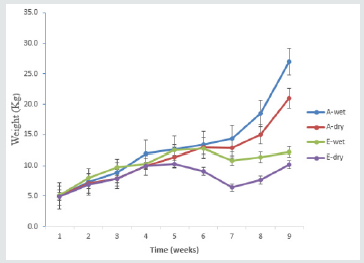
There was a significant (p<0.05) progressive increase in mean
weekly body weight in animals fed BKT bacteria inoculated wet
and dry form of feed when compared with the control animals fed
basal diet in wet and dried form. The group fed BKT in wet feed
form produced significantly heavier animals compared to those fed
dry feed with BKT bacteria. From week four, there was a gradual
increase in weight in all the treatment group and the control group
(p<0.05) but however, from week seven an exponential increase in
weight was observed in the treatment group and a marked decrease
in weight in the control group until week nine when the experiment
was terminated (Figure 1). The group fed PGUT bacteria isolates
showed a significant exponential (p<0.05) (Figure 2) increase in
weight which was as compared to the control group fed with basal
diet in both wet and dry form. However, the group fed PGUT bacteria
in wet form produced significantly (p<0.05) heavier animals as
compared to those fed inoculated dry feed. Also, there was a steady
weight gain between week four and seven in the group fed PGUT
bacteria in wet feed. And this increased significantly (p<0.05) from
week seven to nine, while the group fed dry feed with PGUT bacteria
isolate showed a gradual decrease in weight between week and six
but increased rapidly from week seven to nine. The control group
fed wet feed only showed a gradual increase in body weight from
week four to five then plateaued between week five and six and
gradually decreased till week nine while the control group fed dry
feed only, group started showing a decrease in body weight from
week four to seven before it increased steadily up to the ninth week
(Figure 2). The group fed with PSTAB bacteria in wet and dry form
of feed showed an exponential (p<0.05) increase in body weight as
compared to the control group fed basal diet in wet and dry form.
Though, animals in the treatment wet group where slightly heavier
than those in the treatment dry group. There was a gradual increase
in body weight in the treatment group from week four to seven
which later progressed until week nine. While the control group
showed a slow increase at week four which progressed steadily to
week nine though much lower than the treated groups (Figure 3).
From week four, a gradual increase in body weight was observed
in all the treatment and the control groups but from week seven,
the treatment groups showed a significant (p<0.05) increase in
body weight as compared to the control. Also, for control animals,
a decrease in weight was observed from week five to week seven
with a gradual increase from seven to nine-week (Figure 4).
Figure 2: Mean weekly body weight gain of weaned pig
fed lactobacillus isolates from pig gut in wet and dry feed.
B wet = wet feed + PGUT bacteria Isolate
B dry = dry feed + PGUT bacteria Isolate
E wet = wet feed only
E dry = dry feed only
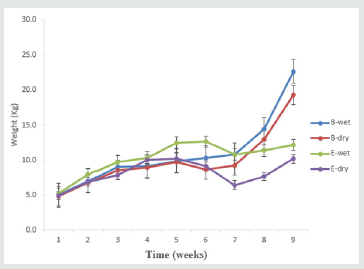
Figure 3: Mean weekly body weight gain of weaned pig
fed lactobacillus isolates containing Bacillus subtilis and
Bacillus pumilis in wet and dry feed.
C wet = wet feed + PSTAB bacterial Isolate
C dry = dry feed + PSTAB bacterial Isolate
E wet = wet feed only
E dry = dry feed only
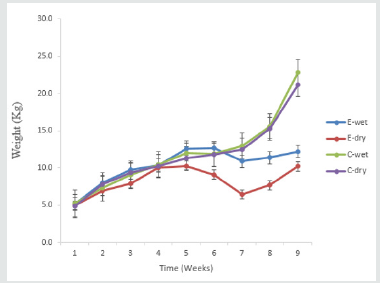
Figure 4: Mean weekly body weight gain of weaned
pigs fed lactobacillus acidiphilus formulated in pig food
supplement (tablet) in wet and dry forms.
D wet = wet feed + PTAB bacteria Isolate
D dry = dry feed + PTAB bacteria Isolate
E wet = wet feed only
E dry = dry feed only
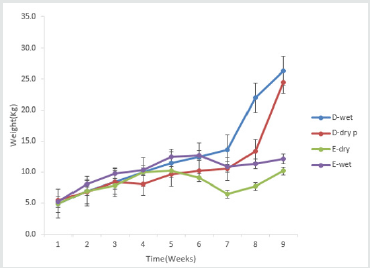
Mean WBC Count
Results of the effect of probiotic bacteria on weekly mean WBC
counts of weaned piglets from pre feeding to nine weeks is presented
in (Table 3). At week 4 WBC was significantly higher in piglets fed
with BKT isolates (p<0.01) when compared to other treatments
and the control groups. Also, there was no significant difference
between PGUT, PSTAB and PTAB, the lowest was observed in the
control group. At 5 weeks, PTAB produce high WBC count (p<0.01)
when compared to other treatment and the control. The result
in 6 weeks revealed that BKT, PGUT and PTAB isolates produced
similar WBC counts at (p<0.05) while PSTAB gave the least WBC
count that was similar to control group (p<0.01). At week 7, PGUT
and BKT had similar values of WBC but significantly higher than
the control (p<0.01). Similarly, there was no significant differences
observed from the treatments PSTAB, PTAB and the control group.
At week 8 BKT, PSTAB and PTAB significantly produce more WBC
count (p<0.01), though similar WBC values were found in PTAB and
control group, PGUT produced the least values. At 9-week PTAB
significantly produce more WBC values (p<0.01). Then any other
treatment and the control. However, BKT and PSTAB gave similar
result that was significantly higher (p<0.05) than PGUT and control
treatment. The feed form as presented in (Table 3). The result
showed that from week 4-9 piglets fed wet feed form significantly
produce more WBC counts than the dry form (p<0.001). However,
WBC did not defer significantly from week 1-3.
Effect of Probiotics on Haematological Parameters
of Weaned Pigs Fed Actobacillus Fermented Feed
Table 3
Mean Hemoglobin Value
The result for mean Hgb values for all the animals fed wet and
dry feed forms in the treatment and control groups were all within
the normal range for piglets (swine).The group fed with isolates
from PTAB in dry feed produced the highest Hgb value which
was significantly higher (p<0.05) than the other treatment group
and the control group (Table 4). (Table 5) The effect of probiotic
bacteria on the weekly mean neutrophil values from 1st week to
9th week of the study. From 1st, 3rd and 5th week of the study, there
was no significant difference (0<0.05) among the treatment groups
and the control. However, at week 4 BKT and PSTAB isolates were
significantly produced higher mean neutrophil values (0<0.01)
than PTAB, PGUT and the control group which was statistically
similar. At week 6, BKT and PSTAB were statistically similar and
produced higher (0<0.01) weekly mean neutrophil values than
PTAB, PGUT and the control group. At week 7, BKT significantly
produced the highest (p<0.01) neutrophil value which was similar
to PSTAB and the control group. PTAB gave the lowest neutrophil
value at this week. At week 8, a similar trend was observed as in
the case of week 7 but the lowest neutrophil value was produced
by PGUT. At 9 weeks, BKT significantly gave the highest neutrophil
values (p<0.01) when compared to their treatment groups that are
similar. However, the control group significantly produced a high
neutrophil value (0<0.05) than PTAB which gave the last neutrophil
value. The feed form as presented in Table 5 showed that from 7-9
weeks piglets fed wet form of food significantly produced more
neutrophil values (p<0.05 and p<0.001). However, neutrophil
values did not differ significantly from week 1-3. (Table 6) The
effect of probiotic bacteria on the weekly mean lymphocyte values
from 1st to 9 weeks of the study. From 1st, 2nd, 4th and 6th week of
the study, there was no significant difference (0<0.05) among the
treatment and control groups. However, at week 7, 8 and 9, BKT
treatment group produced the highest lymphocyte values (p<0.01)
which was statistically higher than PSTAB, PTAB and a PGUT
treatment groups which were statistically similar. The feed form as
presented in Table 6 showed that from 3-9 weeks, piglets fed wet
food forms significantly produced more lymphocyte values (p<0.05
and p<0.01). However, weekly lymphocyte valued did not differ
significantly at weeks 1, 2 and 5.
Table 3: Effect of probiotics on the WBC values of weaned pigs for a period of nine weeks of pre feeding, feeding and challenged
with E. coli infection.
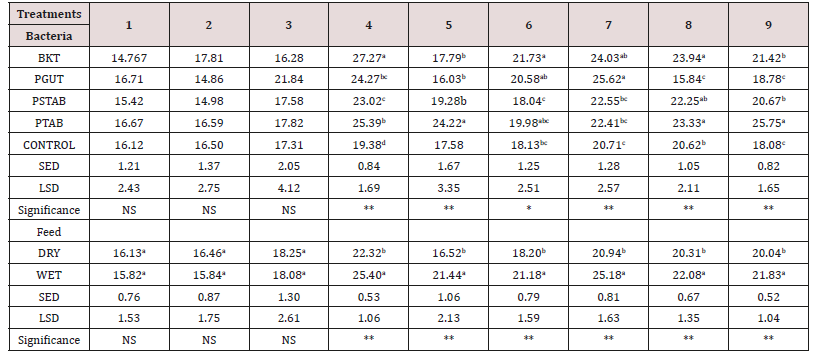
Table 4: Effect of probiotics on the hemogram (HgB) of weaned pigs for a period of nine weeks pre feeding, feeding and challenged
with E. coli infection.
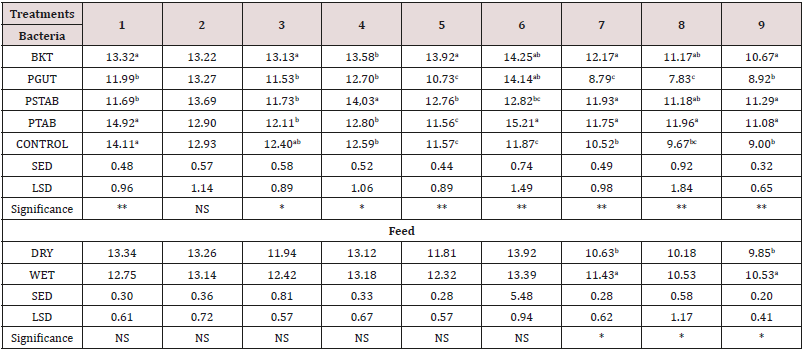
** = Significant at 1% and * at 5% level respectively. Mean within a
column of any set of treatment followed by different letter are
significantly different at 5%level while means followed by similar
letters in column are not significantly different
NS = Not Significant
SED = Standard deviation
BKT = Bacteria from burukutu
PGUT = Bacteria from pig intestine
PSTAB = Patented bacteria
PTAB, Patented bacteria
Table 5: Effect of probiotics on the hemogram (Neutrophils) of weaned pigs for a period of nine weeks pre feeding, feeding and
challenged with E. coli infection.
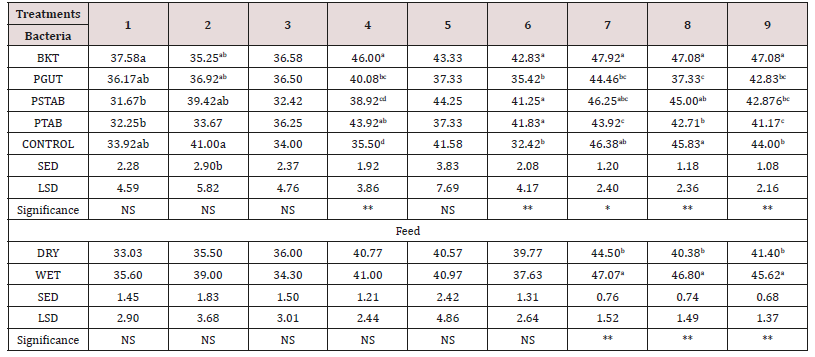
** = Significant at 1% and * at 5% level respectively. Mean within a
column of any set of treatment followed by different letter are
significantly different at 5%level while means followed by similar
letters in column are not significantly different
NS = Not Significant
SED = Standard deviation
BKT = Bacteria from burukutu
PGUT = Bacteria from pig intestine
PSTAB = Patented bacteria
Table 6: Effect of probiotics on the (Lymphocytes) of weaned pigs for a period of nine weeks pre feeding, feeding and challenged
with E. coli infection.
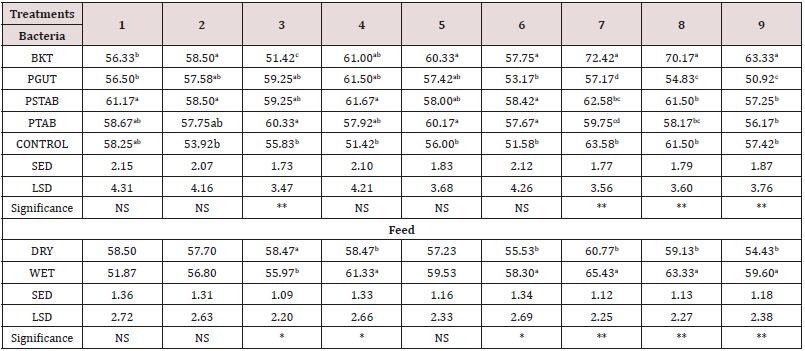
** = Significant at 1% and * at 5% level respectively. Mean within a
column of any set of treatment followed by different letter are
significantly different at 5%level while means followed by similar
letters in column are not significantly different NS = Not Significant.
SED = Standard deviation, BKT = Bacteria from burukutu, PGUT = Bacteria
from pig intestine, PSTAB = Patented bacteria, PTAB,
Patented bacteria
Discussion
This study has shown that there was a significant increase in
weight of animals in the treatment groups fed probiotic bacteria
in the wet and dried form of the feed as compared to the control
wet and dried treatment groups. The observed increase was more
pronounced in groups fed the wet form of the feed than those fed
the dried form. This finding underscores the benefit associated
with feeding diets in a liquid form, and the need for pigs to be
provided with water and feed simultaneously [14,18] and in this
way, the weaned pigs do not need separate learning for feeding
and drinking behavior’s [7,19] Again, [19], demonstrated that the
dry matter intake of the newly weaned pig can be increased by
providing fermented liquid feed. All the groups that received wet
forms of the diet with inclusion of probiotics from locally brewed
drink (burukutu) showed a better growth as compared to those
that received patented bacteria (PSTAB, PTAB) and that from
pig (PGUT). The observed overall increase in weight in the BKT
wet fed and PTAB wet groups as compared to the other groups
(PSTAB and PGUT) indicates that, the probiotic strain used in this
two treatment groups produce good acidity which is required to
ferment liquid feed as reported by [6].that the fermentation of a
nutritionally balanced feed will improve performance by increasing
feed intake and gut health with resultant nutrient utilization. [6],
had also reported a 22.3% improvement in weight gain and a 10.9%
improvement in feed efficiency in the use of fermented liquid feed
as compared to dry feed. This study has also shown that, probiotic
inclusions in the dry form of feed in the BKT dry and PSTAB dry
treatment groups also produced heavier animals than PTAB and
PGUT groups, while the control as well as the PGUT inoculated
dry feeds produced low weights. This observation agrees with
reports that probiotics may not have positive effects on average
daily weight gain and feed conversion of pigs [11,19]. As well as
the reports of [8] that indicated that Lactobacillus fermentum and
Lactobacillus ingluviei were associated with weight gain in animals
while Lactobacillus plantarum was associated with weight loss in
murines similarly, Lactobacillus gasseri was associated with weight
loss both in obese humans and in pigs. The serum profile data
indicated that there was no significant difference in white blood
cell count, neutrophil, lymphocyte and hemoglobin concentration
at the pre feeding period. No bacteria and feed form interaction
were noted for white blood cell count, neutrophil, lymphocyte
and hemoglobin concentration. This could be due to good hygiene
provided for the piglets so that these blood parameters which are
related to immune system were unaffected. There was an increase
in WBC count only when probiotics was fed to the treatment groups
and during challenge with pathogenic E.coli strain from week
four of this study, This observation agrees with the report of [12]
which states that microbial infection or the presence of foreign
bodies or antigens in the circulatory system increases WBC counts.
On the contrary, [12] observed an increase in WBC counts in a
study of unchallenged postweaning piglets (weaned at 21 days of
age) indicating increased total WBC following weaning (and age)
respectively. Therefore, the increased total WBC in our weaned pigs
could be attributed to the effects of the stress induced by weaning
and challenge with E. coli. Lymphocyte counts of the pigs increased
at weeks 4 and weeks 7 as observed in the groups fed probiotics
inoculated feed and challenged with E. coli infection, which was
significantly different from the control Groups challenged with
E. coli infection. [13,20] and [13] had reported that the exact
mechanisms of immune modulation by probiotics have not been
fully explained but they may stimulate different subsets of immune
system cells of which macrophages and lymphocytes are inclusive
[3,21,22]. Mentioned that probiotics containing lactic acid producing
bacteria enhance immune responses and defense activities against
undesirable microorganisms and such protection has been partially
attributed to increase innate immune response. These could have
been the reason for the increase in lymphocyte counts in this study.
Neutrophils are majorly responsible for phagocytosis of pathogenic
microorganisms during the first few hours after their entry into
tissues. There was however a significant increase in the neutrophil
values in all the treatment groups and the control indicating the
possible response of the neutrophils to the foreign bodies. The
significant increase in total protein as observed in this study in
all the treatment groups may be due to improvement in appetite
and feed utilization by the animals. This concurs with the findings
of [23], that increase in total protein indicate a high conversion of
nutrients that can be correlated with immune stimulator through
the action of probiotic flora. However, our results were parallel with
that reported by [9] who reported no significant difference in the
levels of serum albumin and globulin in probiotic treated calves,
however, they observed a significant increase in the levels of serum
total proteins. The findings in this study are also in harmony with
that recorded by [14], in probiotic treated kids [24]. reported that
there was no effect of complex probiotic feeding on total protein
and albumin levels [1,4] also didn’t observe significant effect on
total protein and albumin levels with supplementation of rations
with probiotics in Broiler chickens.
Conclusion
The findings from this study have shown that: The addition of
probiotics basal diets has promising effects on the performance
of weaned piglets in terms of increasing body weight gain and
improving the immune system thus reducing the severity of
infection by pathogenic microorganisms. BKT inoculated feeds
both in the wet and dried form, were found to be better than the
patented bacteria as a probiotic as it increased the body weight
as well as improved the bodies defence by increasing the immune
system cells like WBC. Thus, locally sourced probiotics have like
BKT and PGUT the potential of being patented for use in the Pig
Industry in Nigeria.
Follow on Linkedin : https://www.linkedin.com/company/lupinepublishers
Follow on Twitter : https://twitter.com/lupine_online















